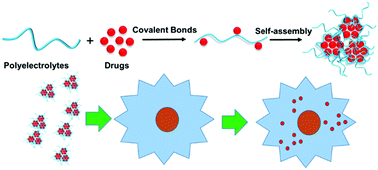Controlled drug release from polyelectrolyte–drug conjugate nanoparticles†
Abstract
Encapsulating drugs in functional nanoparticles provides controlled and targeted release of drugs. In this study, a general approach for encapsulating hydrophobic drugs in polyelectrolyte nanoparticles was developed for a controlled drug release. Gemcitabine (GEM), an anticancer drug for pancreatic ductal adenocarcinoma (PDAC), was used as a model drug to produce poly(acrylic acid) (PAA)–GEM conjugate nanoparticles to achieve a controlled release of GEM in cells. The PAA–GEM conjugate nanoparticles were fabricated by coupling GEM onto PAA through the formation of amide bonds. The hydrophobic interactions of GEM molecules induced the formation of the nanoparticles with the GEM core and PAA shell. Fabrication conditions such as the PAA/GEM ratio and pH were optimized to achieve high structure stability and drug loading efficiency. The size and surface charge of the nanoparticles were characterized by transmission electron microscopy (TEM), dynamic light scattering (DLS) and zeta potential measurement. The optimized PAA–GEM nanoparticles had a size around 12 nm, 30 nm and 60 nm in dry state, water, and phosphate buffered saline (PBS), respectively. The encapsulation efficiency was 29.29 ± 1.7%, and the loading capacity was 9.44 ± 0.46%. Less than 7% GEM was released from the PAA–GEM nanoparticles after 96 hour incubation in phosphate buffered saline. The cytotoxic efficacy of the PAA–GEM nanoparticles in cancer cells was investigated through viability studies of PANC-1, a human pancreatic cancer cell line. It was found that the PAA–GEM nanoparticles had more than a 48 hour delay of releasing GEM and had the same cytotoxic efficacy in PANC-1 cells as free GEM. The uptake of the PAA–GEM nanoparticles by PANC-1 cells was investigated using PAA–GEM labeled by rhodamine G6. Fluorescence and bright field overlay images indicated that the PAA–GEM nanoparticles were taken up by PANC-1 cells within 2 hours. It is believed that the PAA–GEM nanoparticles were decomposed in PANC-1 cells and GEM was released from the nanoparticles.



 Please wait while we load your content...
Please wait while we load your content...